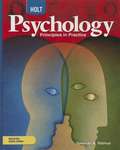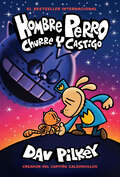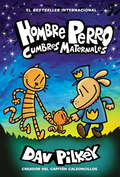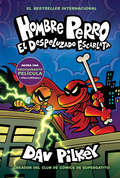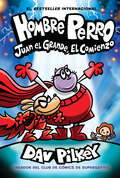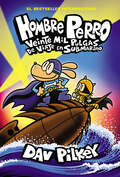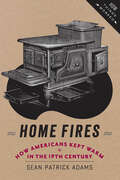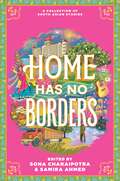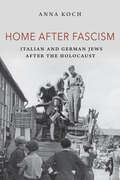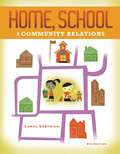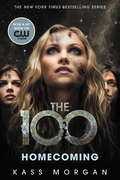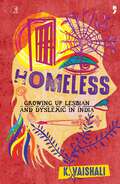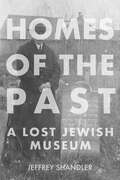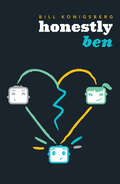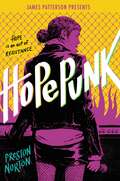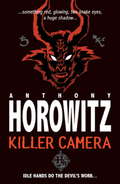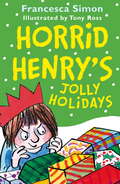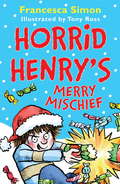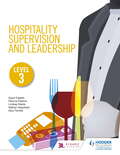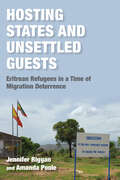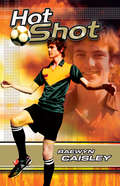- Table View
- List View
Holt Psychology
by Houghton Mifflin HarcourtPsychology: Principles in Practice is designed to help you focus on the main ideas in psychology. The Read to Discover questions, along with the 'Truth or Fiction?" statements that introduce each chapter are intended to guide your reading.
Hombre Perro: Churre y castigo (Hombre Perro)
by Dav PilkeyThe mayor has had enough of Dog Man's shenanigans in the ninth book from worldwide bestselling author and artist Dav Pilkey.¡Hombre Perro ha metido la pata hasta el fondo esta vez! Tiene que entregar su placa y vaciar el escritorio, pero si bien no tiene trabajo aún le quedan esperanzas. Con sus amigos de su lado, ¿podrá Hombre Perro salir del hoyo y regresar gateando al cuerpo policial?Dog Man's really done it this time! He hands over his badge and clears out his desk, but while he may be out of a job, he's not yet out of hope. With his friends at his side, can Dog Man dig himself out of this hole and paw his way back onto the force?
Hombre Perro: Cumbres maternales (Hombre Perro)
by Dav PilkeyDog Man and Petey face their biggest challenges yet in the tenth Dog Man book from worldwide bestselling author and illustrator Dav Pilkey.A Hombre Perro se le acaba la suerte, Pedrito confronta su pasado no tan perfecto y el abuelo anda haciendo de las suyas. El mundo está fuera de control con los nuevos villanos que han llegado a la ciudad. La situación se ve oscura y sin esperanzas. Sin embargo, no todo está perdido. ¿Podrá arreglar las cosas el increíble poder del amor?Dog Man is down on his luck, Petey confronts his not so purr-fect past, and Grampa is up to no good. The world is spinning out of control as new villains spill into town. Everything seems dark and full of despair. But hope is not lost. Can the incredible power of love save the day?
Hombre Perro: El Despeluzado Escarlata (Hombre Perro)
by Dav Pilkey¡Nuestro superhéroe canino regresa en DOG MAN: THE SCARLET SHEDDER, la duodécima novela gráfica llena de suspense y divertidísima de la serie número uno en ventas mundiales del galardonado autor e ilustrador Dav Pilkey!¡Qué peste! ¡Hombre Perro ha sido rociado por un zorrillo! Tras sumergirlo en jugo de tomate el olor desaparece, pero el color rojo escarlata no se le quita. ¡Este valiente superhéroe, ahora exiliado, debe luchar para salvar a los ciudadanos que lo rechazaron! ¿El fin justificará los medios para Pedrito, quien a regañadientes regresa a la vida del crimen para ayudar a Hombre Perro? ¿Y quién dará un paso al frente cuando un villano completamente nuevo y nunca antes visto desate un ejército de robots de I.A.?Our canine superhero returns in DOG MAN: THE SCARLET SHEDDER, the suspenseful and hilarious twelfth graphic novel in the #1 worldwide bestselling series by award-winning author and illustrator Dav Pilkey!P.U.! Dog Man got sprayed by a skunk! After being dunked in tomato juice, the stink is gone but the scarlet red color remains. Now exiled, this spunky superhero must struggle to save the citizens who shunned him! Will the ends justify the means for Petey, who's reluctantly pulled back into a life of crime in order to help Dog Man? And who will step forward when an all-new, never-before-seen villain unleashes an army of A.I. robots?
Hombre Perro: Juan el Grande, el comienzo (Hombre Perro)
by Dav Pilkey¡El superhéroe favorito de todos está de vuelta en la emocionante decimotercera novela gráfica de la serie más exitosa del galardonado autor e ilustrador Dav Pilkey! Es heroico, sincero y divertidísimo: ¡es Hombre Perro!¡Sigue a Hombre Perro y a tus súper favoritos amigos mientras salvan la ciudad de un nuevo y malvado malhechor! Para aventuras de novelas gráficas más sentidas, sigue a Aleta y a Peque Pedrito en la serie El Club de Cómics de Supergatito. Y no olvides la serie que lo empezó todo: ¡El Capitán Calzoncillos!Everyone's favorite superhero is back in the thrilling thirteenth graphic novel in the #1 worldwide bestselling series by award-winning author and illustrator Dav Pilkey! It's heroic, it's heartfelt, it's hilarious -- it's Dog Man!Join Dog Man and your favorite supa buddies as they save the city from a dastardly new wrongdoer! For more heartfelt graphic novel adventures, join Flippy and Li'l Petey in the Cat Kid Comic Club series. And don't forget the series that started it all: Captain Underpants!
Hombre Perro: Veinte mil pulgas de viaje en submarino (Hombre Perro)
by Dav PilkeyDOG MAN IS BACK! The highly anticipated new graphic novel in the #1 worldwide bestselling series starring everyone's favorite canine superhero by award-winning author and illustrator Dav Pilkey!Piggy está de vuelta, y su nuevo plan es el más diabólica hasta el momento. ¿QUÉ nuevos villanos hay en el horizonte? ¿DE DÓNDE salieron? Y ¿QUIÉN dará un paso adelante para salvar a la ciudad cuando los sinvergüenzas saboteen a nuestros superamigos? Hombre Perro: Veinte mil pulgas de viaje en submarino, con sus temas de amistad y de hacer el bien, está lleno de acción y risas. Incluye un "Mordiscorama", una nueva canción, un ácaro monstruoso y ¡mucho más que antes! ¡ES HERÓICO, ES ÉPICO!Piggy has returned, and his newest plot is his most diabolical yet. WHAT other new villains are on the horizon? WHERE are they all coming from? And WHO will step forward to save the city when scoundrels sabotage our Supa Buddies? With themes of friendship and doing good, Dog Man: Twenty Thousand Fleas Under the Sea is packed with action and hilarity. Featuring "Chomp-O-Rama," a brand-new song, a monstrous Mighty Mite -- and so much more than ever before! IT'S HEROIC, IT'S EPIC!
Home Fires: How Americans Kept Warm in the Nineteenth Century (How Things Worked)
by Sean Patrick AdamsHome heating networks during the Industrial Revolution helped create the modern dependence on fossil fuel energy in America.Home Fires tells the fascinating story of how changes in home heating over the nineteenth century spurred the growth of networks that helped remake American society. Sean Patrick Adams reconstructs the ways in which the "industrial hearth" appeared in American cities, the methods that entrepreneurs in home heating markets used to convince consumers that their product designs and fuel choices were superior, and how elite, middle-class, and poor Americans responded to these overtures.Adams depicts the problem of dwindling supplies of firewood and the search for alternatives; the hazards of cutting, digging, and drilling in the name of home heating; the trouble and expense of moving materials from place to place; the rise of steam power; the growth of an industrial economy; and questions of economic efficiency, at both the individual household and the regional level. Home Fires makes it clear that debates over energy sources, energy policy, and company profit margins have been around a long time.The challenge of staying warm in the industrializing North becomes a window into the complex world of energy transitions, economic change, and emerging consumerism. Readers will understand the struggles of urban families as they sought to adapt to the ever-changing nineteenth-century industrial landscape. This perspective allows a unique view of the development of an industrial society not just from the ground up but from the hearth up.
Home Has No Borders
by Sona Charaipotra Samira AhmedFrom New York Times bestselling author Samira Ahmed and Sona Charaipotra comes this uplifting contemporary teen anthology celebrating South Asian stories and writers. From first crushes to first heartbreaks, complicated family dynamics to community relationships, this powerful collection of stories explores race, class, culture, language, and the very idea of home as both a place and a feeling.Edited by Samira Ahmed and Sona Charaipotra and featuring some of the most acclaimed, bestselling South Asian authors writing for teens today—this is an essential collection of captivating stories about what it means to be South Asian.With stories by:Anuradha D. Rajurkar, award-winning author of American BetiyaFatimah Asghar, author of If They Come for Us and cocreator behind the Emmy-nominated miniseries Brown GirlsJasmin Kaur, celebrated author of When You Ask Me Where I’m Going and If I Tell You the TruthNavdeep Singh Dhillon, author of Sunny G’s Series of Rash DecisionsNikesh Shukla, acclaimed author of Coconut Unlimited; The One Who Wrote Destiny; Run, Riot; The Boxer; and Stand UpNisha Sharma, celebrated author of My So-Called Bollywood Life, Radha and Jai’s Recipe for Romance, and The Karma MapRajani LaRocca, Newbery Honor–winning author of Red, White, and WholeSamira Ahmed, New York Times bestselling author of Love, Hate & Other Filters, Internment, Mad, Bad & Dangerous to Know, Hollow Fires, and the Amira & Hamza middle grade duology,Sheba Karim, award-winning author of Skunk Girl, That Thing We Call a Heart, Mariam Sharma Hits the Road, and The Marvelous Mirza GirlsTanuja Desai Hidier, critically acclaimed author of Born Confused and Bombay BluesSarah Mughal Rana, author of Hope Ablaze Tanya Boteju, author of Kings, Queens, and In-Betweens and BruisedTashie Bhuiyan, author of Counting Down with You, A Show for Two, and Stay with My HeartVeera Hiranandani, Newbery Honor–winning author of The Night Diary, How to Find What You’re Not Looking For, and Amil and the AfterKanwalroop SinghRekha KuverPraise for Magic Has No Borders:A New York Public Library Best Book of the Year for Teens 2023!“This anthology pushes the boundaries of fantasy, drawing on a broad range of settings, figures, and tales from South Asian religions, mythologies, and history...engrossing, and entertaining.” —Kirkus Reviews"This collection of short stories featuring South Asian characters and magic fills a void while celebrating culture and genre. As short story collections go, this strong selection featuring South Asian characters is joyous and original. Add it to the shelf." —School Library Journal"Editors Ahmed and Charaipotra have gathered a host of South Asian authors and illustrators to create a marvelous anthology, with fourteen fantasy and science fiction stories that deeply explore legends, myths, and historical events, all reimagined from different regions and cultures in the South Asian diaspora. Readers will indeed find magic within this breadth of stories." —The Bulletin of the Center for Children's Books
Home after Fascism: Italian and German Jews after the Holocaust (The Modern Jewish Experience)
by Anna KochHome after Fascism draws on a rich array of memoirs, interviews, correspondence, and archival research to tell the stories of Italian and German Jews who returned to their home countries after the Holocaust. The book reveals Jews' complex and often changing feelings toward their former homes and highlights the ways in which three distinct national contexts—East German, West German, and Italian—shaped their answers to the question, is this home? Returning Italian and German Jews renegotiated their place in national communities that had targeted them for persecution and extermination. While most Italian Jews remained deeply attached to their home country, German Jews struggled to feel at home in the "country of murderers." Yet, some retained a sense of belonging through German culture and language or felt attached to a specific region or city. Still others looked to the future; socialist and communists of Jewish origin hoped to build a better Germany in the Soviet Occupied Zone. In all three postwar states, surviving Jews fought against persistent antisemitism, faced the challenge of recovering lost homes and possessions, struggled to make sense of their persecution, and tried to find ways to reclaim a sense of belonging. Wide ranging and moving, Home after Fascism enriches our understanding of Jews' homecoming experiences after 1945. It reveals the deep affection and persistent love people feel for their homes, the suffering that comes with losing them, and the challenges of a return.
Home, School, and Community Relations
by Carol GestwickiThis practical book is an indispensable guide for home-school-community collaborations. It meets the needs of current and practicing teachers, as well as administrators, who are trying to create effective partnerships with families. An overview of modern families and their complex roles sensitizes teachers to the diversity and needs of families they will encounter. The book also fully discusses both the benefits of creating productive partnerships and the barriers that teachers must overcome. Abundant examples clarify the book's practical and effective communication strategies. Current developments in the field of early childhood education are emphasized, including legislative mandates in education, professional standards of the field, and strategies for working with families of students with diverse learning needs.
Homecoming (The 100 #3)
by Kass MorganHumanity is coming home.Weeks after landing on Earth, the Hundred have managed to create a sense of order amidst their wild, chaotic surroundings. But their delicate balance comes crashing down with the arrival of new dropships from space.These new arrivals are the lucky ones-back on the Colony, the oxygen is almost gone-but after making it safely to Earth, GLASS's luck seems to be running out. CLARKE leads a rescue party to the crash site, ready to treat the wounded, but she can't stop thinking about her parents who may still be alive. Meanwhile, WELLS struggles to maintain his authority despite the presence of the Vice Chancellor and his armed guards, and BELLAMY must decide whether to face or flee the crimes he thought he'd left behind. It's time for the Hundred to come together and fight for the freedom they've found on Earth, or risk losing everything-and everyone-they love.
Homeless: Growing Up Lesbian and Dyslexic in India
by K. VaishaliAfter discovering she&’s lesbian and dyslexic at 20, Vaishali begins to untangle her anxieties around reading and writing. She comes out to her mother at 22 and leaves her Bombay home to make her own way. In a dingy, insect-ridden yet rent-free hostel room in Hyderabad with a door that doesn&’t quite close, she tries to make the best of the situation by writing a book about her experiences. As she writes, she finds the past has a way of catching up with her, even as she explores her dyslexia, homosexuality, and the clitoris; falling in love and recovering from a harrowing breakup; academic failure, loneliness, and homophobia; living with sickness, anxiety, depression, and her caste, gender, and body. This is the story of Vaishali's relationship with her many truths and the truths of many young people in India.
Homes of the Past: A Lost Jewish Museum (The Modern Jewish Experience)
by Jeffrey ShandlerHomes of the Past tells the powerful story of how immigrant Jewish scholars in 1940s New York sought to build a museum to commemorate their lost worlds and people. Among the Jews who arrived in the United States in the early 1940s were a small number of Polish scholars who had devoted their professional lives to the study of Europe's Yiddish-speaking Jews at the YIVO Institute for Jewish Research. Faced with the devastating knowledge that returning to their former homes and resuming their scholarly work there was no longer viable, they sought to address their profound sense of loss by continuing their work, under radically different circumstances, to document the European Jewish lives, places, and ways of living that were being destroyed. In pursuing this daunting agenda, they made a remarkable decision: they would create a museum to memorialize East European Jewry and educate American Jews about this legacy. YIVO scholars determinedly pursued this undertaking for several years, publicizing the initiative and collecting materials to exhibit. However, the Museum of the Homes of the Past was abandoned shortly after the war ended.With insight and clarity, Jeffrey Shandler draws upon the surviving archival sources to tell the story of the purpose, development, and ultimate fate of the Museum of the Homes of the Past.Homes of the Past explores this largely unknown episode of modern Jewish history and museum history and demonstrates that the project, even though it was never realized, marked a critical inflection point in the dynamic interrelations between Jews in America and Eastern Europe.
Honestly Ben (Openly Straight Ser.)
by Bill KonigsbergIn the companion to Openly Straight, Ben confronts pressure at school, repression at home, and his passion for two very different people in figuring out what it takes to be Honestly Ben.The companion to the award-winning Openly Straight, called "remarkable...deeply satisfying and as honest as its appealing protagonist" (Booklist). Perfect for fans of David Levithan, Andrew Smith, and John Green!Ben Carver is back to normal. He's working steadily in his classes at the Natick School. He just got elected captain of the baseball team. He's even won a full scholarship to college, if he can keep up his grades. All that foolishness with Rafe Goldberg the past semester is in the past.Except...There's Hannah, the gorgeous girl from the neighboring school, who attracts him and distracts him. There's his mother, whose quiet unhappiness Ben is noticing for the first time. School is harder, the pressure higher, the scholarship almost slipping away. And there's Rafe, funny, kind, dating someone else . . . and maybe the real normal that Ben needs.
Honey Blonde Chica: A Novel
by Michele SerrosEvie Gomez is one chill chica. She and best friend Raquel hang with the Flojos, a kick-back crew named for their designer flip-flops. And their habit of doing absolutely nothing. But the return of long-lost amiga mejor Dee Dee wrecks Evie and Raquel's Flojo flow. A few years in Mexico City have transformed their shy, skinny, brunette Dee Dee into a Sangro nightmare. Dee Dee has reinvented herself as "Dela," complete with tight designer threads, freaky blue contacts, and that signature blonde hair. When Raquel wants precisely nada to do with the new Dela, Evie finds herself caught between two very different friends. At heart, is Evie a Cali-casual Flojo chick or a sexy Sangro diva? How's a chica to choose?
Honey, Baby, Sweetheart
by Deb CalettiA summer romance headed for heartbreak turns into a mother-daughter road trip in the name of true love in this story of love, loss, and redemption from Printz Honor medal winner and National Book Award finalist Deb Caletti. It is summer in the northwest town of Nine Mile Falls, and Ruby McQueen—ordinarily dubbed The Quiet Girl—finds herself hanging out with gorgeous, rich, thrill-seeking Travis Becker. With Travis, Ruby can be someone she&’s never been before: Fearless. Powerful. But Ruby is in over her head, risking more and more when she&’s with him. In an effort to keep Ruby occupied and mend her own broken heart, her mother, Ann, drags Ruby to the weekly book club she runs for seniors. At first, Ruby can&’t imagine a more boring way to spend an afternoon, but she is soon charmed by the women she&’s spending time with. And when the group discovers one of their own members is the subject of the tragic love story they are reading, Ann and Ruby ditch their respective obsessions to spearhead a reunion between the long-ago lovers. They&’re in search of a happy ending…but for who? This lyrical, multigenerational story of love, loss, and redemption speaks to everyone who has ever been in love—and lived to tell the tale.
Hopepunk
by Preston NortonFollowing the disappearance of her sister, Hope Cassidy rebels against a life that once controlled her, as she learns about forgiveness and redemption—and how hope is the ultimate act of rebellion—in this heartfelt and funny novel. Growing up in a conservative Christian household isn&’t easy for rock-obsessed Hope Cassidy. She's spent her whole life being told that the devil speaks through Led Zeppelin, but it&’s even worse for her sister, Faith, who feels like she can&’t be honest about dating the record shop cashier, Mavis. That is, until their youngest sister hears word of their "sinful" utopia and outs Faith to their parents. Now there&’s nowhere for Faith to go but the Change Through Grace conversion center…or running away. Following Faith&’s disappearance, their family is suddenly broken. Hope feels a need to rebel. She gets a tattoo and tries singing through the hurt with her Janis Joplin-style voice. But when her long-time crush Danny comes out and is subsequently kicked out of his house, Hope can&’t stand by and let history repeat itself. Now living in Faith&’s room, Danny and Hope strike up a friendship...and a band. And their music just might be the answer to dethroning Alt-Rite, Danny&’s twin brother's new hate-fueled band. With a hilarious voice and an open heart, Hopepunk is a novel about forgiveness, redemption, and finding your home, and about how hope is the ultimate act of rebellion.
Horowitz Horror: Killer Camera
by Anthony HorowitzTwo spine-chilling short stories by Anthony Horowitz, a master-storyteller and the best-selling author of the Alex Rider series. Jamie is pleased with the camera he finds at a car boot sale - that is until he realises everything he photographs breaks . . . or dies.Henry soon finds out that his new computer has a life of its own - and it's not afraid to gamble with people's lives.
Horrid
by Katrina LenoFrom the author of You Must Not Miss comes a haunting contemporary horror novel that explores themes of mental illness, rage, and grief, twisted with spine-chilling elements of Stephen King and Agatha Christie.Following her father's death, Jane North-Robinson and her mom move from sunny California to the dreary, dilapidated old house in Maine where her mother grew up. All they want is a fresh start, but behind North Manor's doors lurks a history that leaves them feeling more alone . . . and more tormented.As the cold New England autumn arrives, and Jane settles in to her new home, she finds solace in old books and memories of her dad. She steadily begins making new friends, but also faces bullying from the resident "bad seed," struggling to tamp down her own worst nature in response. Jane's mom also seems to be spiraling with the return of her childhood home, but she won't reveal why. Then Jane discovers that the "storage room" her mom has kept locked isn't for storage at all -- it's a little girl's bedroom, left untouched for years and not quite as empty of inhabitants as it appears . . .Is it grief? Mental illness? Or something more . . . horrid?
Horrid Henry's Jolly Holidays
by Tony Ross Francesca SimonCelebrate a truly horrid Christmas with Horrid Henry and this festive storybook bind-up.Packed with six favourite Horrid Henry stories, plus bonus content to make sure Christmas is stuffed full of cheeky festive fun.This is the perfect stocking filler for Horrid Henry fans everywhere!Stories included are:Horrid Henry's Birthday Party Horrid Henry's Sleepover Horrid Henry Goes ShoppingHorrid Henry and the Bogey BabysitterHorrid Henry's Horrid WeekendHorrid Henry Robs the Bank
Horrid Henry's Merry Mischief
by Tony Ross Francesca SimonCelebrate a truly horrid Christmas with Horrid Henry and this festive storybook bind-up.Packed with six favourite Horrid Henry stories, plus bonus content to make sure Christmas is stuffed full of cheeky festive fun.This is the perfect stocking filler for Horrid Henry fans everywhere!
Hospitality Supervision and Leadership Level 3
by Patricia Paskins Ketharanathan Vasanthan Gary FarrellyPrepare for assessment and master the skills and knowledge you need to succeed as a hospitality and catering supervisor with this support resource. Covering all of the latest mandatory and most popular optional units, with a strong focus on preparation for assessment, this will be an essential resource for anyone working towards the Level 3 NVQ Diploma in Hospitality Supervision and Leadership, whether in college or in the workplace. It also provides support for those completing the Hospitality Supervision and Leadership apprenticeship. - Provides all of the essential knowledge and skills any supervisor working in the hospitality industry will need: from supporting, motivating and developing staff, to customer service skills, problem solving and controlling resources - Develops understanding of the assessment requirements with clear explanations of all criteria - Helps you to build your portfolio, with guidance on suitable evidence and activities that provide assessment opportunities - Prepares you for professional discussions and questioning with knowledge checks at the end of each unit to test your understanding
Hosting States and Unsettled Guests: Eritrean Refugees in a Time of Migration Deterrence (Worlds in Crisis: Refugees, Asylum, and Forced Migration)
by Jennifer Riggan Amanda PooleAs wealthy countries build walls to keep migrants out, countries in the Global South are celebrated for their hospitality towards refugees. Hosting States and Unsettled Guests asks the question: did these policies enable refugees to consider their new country home?Beginning in 2016, Ethiopia promoted local integration, economic opportunities, and access to education for refugees in order to encourage them to stay long-term rather than migrate towards Europe. But by 2020 a political overhaul and the outbreak of war in Northern Ethiopia foreclosed these opportunities, particularly for Eritrean refugees in Ethiopia. How did Eritrean refugees envision their future in light of the discrepancy between promising policies and ongoing instability? Using ethnographic interviews and participant observation with government officials, NGOs, and refugees in three camps in northern Ethiopia and Addis Ababa, Jennifer Riggan and Amanda Poole explore refugee notions of progress, care, hope, and futurity. Caught at the intersection of teleological violence and temporal agency, refugees endure the present and tenaciously produce a sense of the future even when their efforts to progress are repeatedly challenged. An important read, Hosting States and Unsettled Guests makes key empirical and theoretical contributions in forced migration studies, East African studies, anthropology and international education. Riggan and Poole deftly shift the focus of refugee studies away from Europe to regions in the Global South to understand the violence of emerging forms of migration deterrence.
Hot Boy Summer
by Joe JiménezFour gay teens in Texas have the summer of their lives while discovering important truths about realness, belonging, and friendship in this &“explosive prose debut for the gays and theys growing up outside of the box&” (Booklist, starred review).Mac has never really felt like he belonged. Definitely not at home—his dad&’s politics and toxic masculinity make a real connection impossible. He thought he fit in on the baseball team, but that&’s only because he was pretending to be someone he wasn&’t. Finding his first gay friend, Cammy, was momentous; finally, he could be his authentic self around someone else. But as it turned out, not really. Cammy could be cruel, and his &“advice&” often came off way harsh. And then, Mac meets Flor, who shows him that you can be both fierce and kind, and Mikey, who is superhot and might maybe think the same about him. Over the course of one hot, life-changing summer, Mac will stand face-to-face with desire, betrayal, and letting go of shame, which will lead to some huge discoveries about the realness of truly belonging. Told in Mac&’s infectious, joyful, gay AF voice, Hot Boy Summer serves a tale as important as hope itself: four gay teens doing what they can to connect and have the fiercest summer of their lives. New friendships will be forged, hot boys will be kissed…and girl, the toxic will be detoxed.
Hot Shot
by Raewyn CaisleyHow did Harry Kewell do it? That?s what Sam wants to know. How did he handle being called a `hot shot? by his team-mates? Sam bets Harry?s coach never benched him for winning the game single-handedly! And what about Harry?s dad? Did he think soccer was for sissies too? Things are getting too tough for Sam to handle, until he meets Manuel Luque, an ex-professional English soccer player. At last there?s someone on his side! But even though Manuel?s got the contacts, the news isn?t all good. Just what does it take for a young Aussie soccer star to realise his dream? From Raewyn Caisley, the acclaimed and established author of TOP MARKS, NOT CRICKET, IN UNION, TENNIS STAR, FREE STYLE and GREAT LEAD, comes another book in the popular Junior Sports Series.
